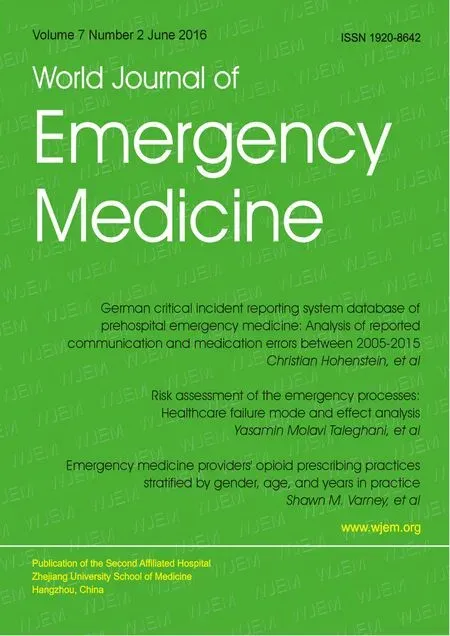A scoring system for assessing the severity of acute diarrhea of adult patients
2016-07-08HongliXiaoSuxiaMaHaiyuQiXiaoliLiYanWangChenghongYinDepartmentofEmergencyMedicineBeijingFriendshipHospitalCapitalMedicalUniversityBeijingChinaDepartmentofEmergencyMedicineBeijingShijingshanHospitalBeijingChinaDepartmentof
Hong-li Xiao, Su-xia Ma, Hai-yu Qi, Xiaoli Li, Yan Wang, Cheng-hong YinDepartment of Emergency Medicine, Beijing Friendship Hospital, Capital Medical University, Beijing, ChinaDepartment of Emergency Medicine, Beijing Shijingshan Hospital, Beijing, ChinaDepartment of Internal Medicine, Beijing Obstetrics and Gynecology Hospital, Capital Medical University, Beijing, China Corresponding Author: Cheng-hong Yin, Email: modscn@6.com
A scoring system for assessing the severity of acute diarrhea of adult patients
Hong-li Xiao1, Su-xia Ma2, Hai-yu Qi1, Xiaoli Li1, Yan Wang1, Cheng-hong Yin31Department of Emergency Medicine, Beijing Friendship Hospital, Capital Medical University, Beijing, China
2Department of Emergency Medicine, Beijing Shijingshan Hospital, Beijing, China
3Department of Internal Medicine, Beijing Obstetrics and Gynecology Hospital, Capital Medical University, Beijing, China Corresponding Author: Cheng-hong Yin, Email: modscn@126.com
BACKGROUND: Diarrhea is frequently seen in developed and developing countries, and severe diarrhea is characterized by the high risk of death. Thus, it is very important to assess the severity of diarrhea early. We conducted a multi-center study to identify risk factors for the severity of diarrhea in adult patients and formulate an adult diarrhea state score (ADSS) for out-patient clinicians.
METHODS: A total of 219 adult patients with acute diarrhea were divided into two groups: 132 patients with mild diarrhea and 87 with severe diarrhea. Logistic regression was used to determine risk factors for the severity of diarrhea. The risk factors were assessed and an ADSS was formulated. Receiver operating characteristic (ROC) analysis was made to evaluate the diagnostic accuracy of ADSS, and the Kappa test was used to confi rm the diagnostic reliability.
RESULTS: Five risk factors for evaluating the severity of diarrhea in adults included age (P<0.05),axillary temperature (P<0.01), mean arterial pressure (P<0.01), white blood cell count (WBC; P<0.01),and WBC in stool (P<0.01). The area under the ROC curve for ADSS was 0.958 when the cut off value was 4 (a sensitivity of 0.909; a specifi city of 0.874), and the Kappa value was 0.781 (P<0.05).
CONCLUSION: The risk factors associated with the pathogenic condition of diarrhea were identifi ed, quantifi ed and formulated into an ADSS, which has high diagnostic accuracy and reliability for the early identifi cation of patients with severe acute diarrhea.
KEY WORDS:Acute diarrhea; Severity; Score
World J Emerg Med 2016;7(2):130–134
INTRODUCTION
Diarrhea is one of the most common clinical symptoms. According to the statistics of the World Health Organization,the incidence of diarrhea is as high as 30–50 billion episodes worldwide each year, and 5 to 10 million of them were at a high risk of death due to severe diarrhea.[1]Therefore, the assessment of patients with diarrhea is critically important. The most commonly used systems to assess the severity of illness are acute physiology and chronic health evaluation (APACHE) II, APACHE III, simplified acute physiology score (SAPS) II, and sequential organ failure assessment (SOFA). However, these systems are mainly used to predict mortality at the time of admission to a critical care unit, and require complex computation of multiple variables. The present study was to establish a simple, fast and practical scoring system for doctors to timely and accurately evaluate the severity of diarrhea in adult patients by prospectively analyzing the clinical data of 219 patients.
METHODS
Design and setting
This study is an observational study of independent risk factors related to severe acute diarrhea.
Beijing Friendship Hospital and Beijing Xuanwu Hospital affi liated to Capital Medical University are largegeneral hospitals each with 1 000 beds. Both hospitals have a capacity for up to 5 000 outpatient visits per day.
Patients
A total of 219 patients with acute diarrhea were treated at the intestinal clinics, general wards and ICUs of Beijing Friendship Hospital and Beijing Xuanwu Hospital between April 2007 and December 2008. Inclusion criteria for the patients were as follows: defecation frequency ≥3 per day, change of fecal characteristics, age ≥18 years old,and diarrhea course ≤2 weeks. In this series, there were 132 mild patients and 87 severe patients. The patients who were not hospitalized were defi ned as mild, and those who were hospitalized or admitted to the ICU as severe.
Data collection
Clinical data of the patients were collected using a unifi ed case observation table that included history of chronic disease,clinical symptoms, signs and laboratory examinations using retrospective and controlled clinical research methods. The patients were followed up for 2 weeks.
Statistical analysis
Data analyses were performed using Statistical Package for Social Sciences software for Windows, version 16.0 (SPSS Inc, Chicago, IL, USA), and P values <0.05 were considered statistically significant. First, risk factors for severe diarrhea were identifi ed. Abnormal symptoms, signs and laboratory data of the mild patients were compared with those of the severe patients. Differences between the two groups were assessed using Student's t test or the non-parametric Mann-Whitney U test for continuous variables, and the Chi-square test for categorical variables. Second, to further evaluate these differences, independent risk factors for the severe group were identified by binary logistic regression to calculate odds ratios (OR) and 95% confidence intervals (CI). Third, the independent risk factors were weighted and formulated into a table for the adult diarrhea state score (ADSS). Finally, the operating characteristics (sensitivity and specificity) of the ADSS scoring system were calculated using receiver operator characteristic (ROC) curves and the diagnostic reliability of ADSS was calculated using the Kappa test.
RESULTS
General information
A total of 219 patients with acute diarrhea were included in the study. Their median age was 49.01 years (range 16 to 93 years). 115 patients were male and 107 had a history of chronic disease.
The patients were older in the severe group (87 patients) than those in the mild group (132 patients)(median age: 41.94 vs. 58.09 years; range 18 to 79 vs. 18 to 96 years, P<0.01), and the incidence of chronic disease was higher in the severe group than in the mild group ( 36.4% vs. 67.8%, P<0.01).
Analysis of individual factors
Continuous variables were analyzed by Student's t test (Table 1), and categorical variables by the Chi-square test (Table 2). Overall, 19 factors were significantly different between the two groups (P<0.05).
Independent risk factors for pathogenetic condition
Logistic regression revealed five independent riskfactors for severe diarrhea: age (P<0.05), temperature (P<0.001), MAP (P<0.01), WBC (P<0.01), and WBC in stool (P<0.01) (Table 3).
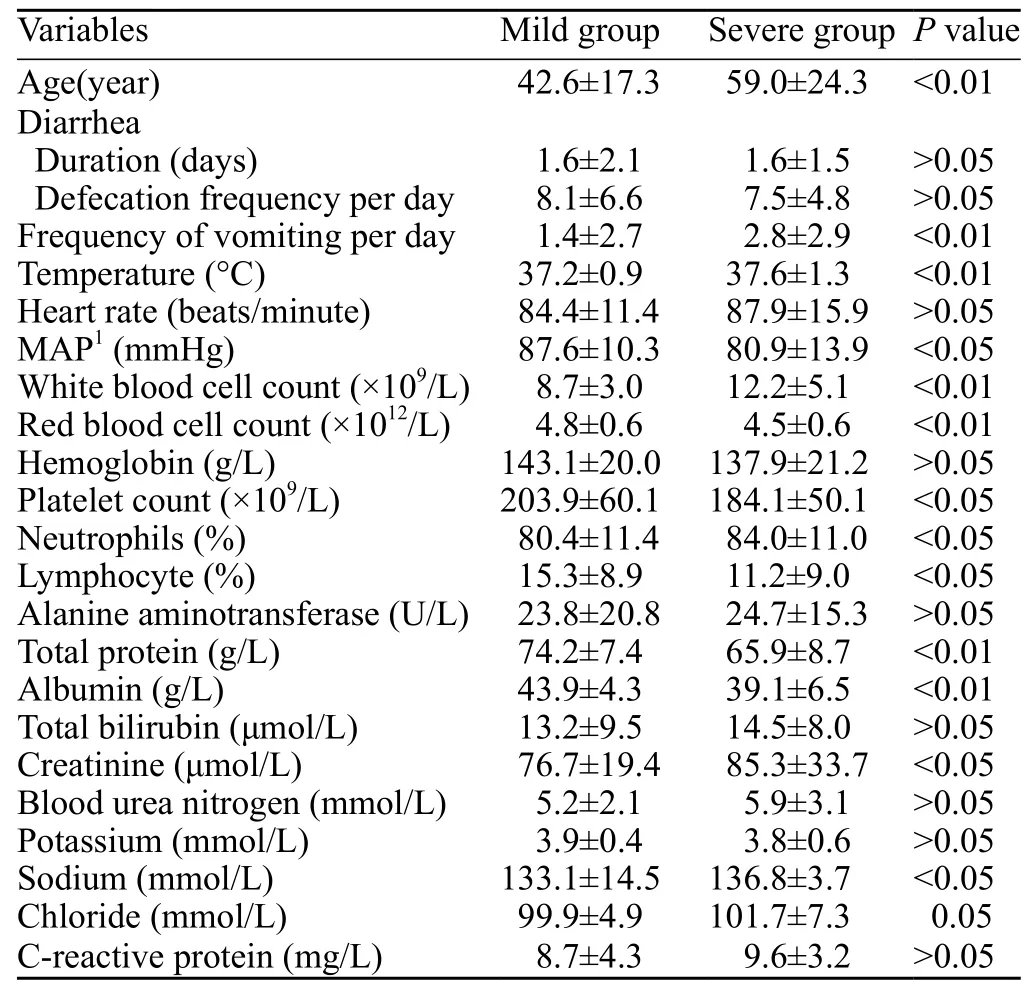
Table 1. Comparison of continuous variables between the mild and severe groups
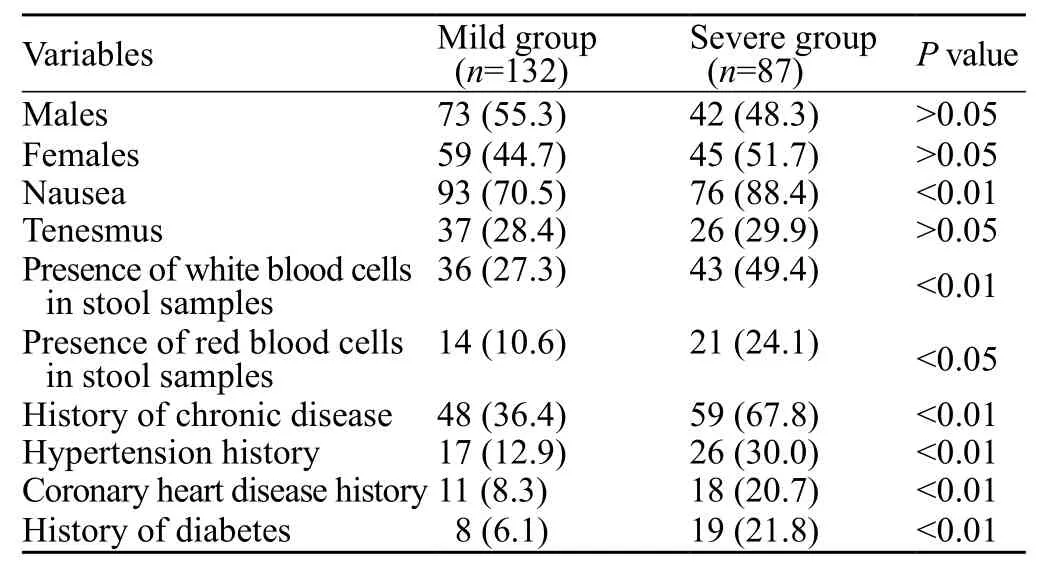
Table 2. Comparison of categorical variables between the mild and severe groups, n (%)
Formulation and evaluation of ADSS
Standard regression coefficient was determined using the weighting criteria for each parameter (Table 4). Then each score indicated a factor. The accuracy and reliability of the scoring system were assessed with ROC curve and the Kappa test. The area under the ROC curve (AUC) for ADSS was 0.958 (Figure 1), the standard error (SE) was 0.010, and 95% CI was 0.936–0.981. A score of 4 was considered to represent a severe condition (a specifi city of 87.4% and a sensitivity of 90.9%), and a score of 4 or higher would detect 90.9% of patients in a severe condition with poor prognosis, whereas 9.1% of those considered to have a severe condition would actually have a mild condition. Only 12.6% of patients in the mild condition had a score of 4 or higher. The Kappa test was used to verify the reliability of ADSS, and the results showed that ADSS and clinical diagnostic criteria had good consistency (Kappa: 0.781, P<0.01).
ADSS in non-hospitalized patients and inpatients
The scores of non-hospitalized patients ranged from 0 to 6. Most of the patients (83.54%) had a score of 0–5. The percentage of inpatients with a score of 4 or over was higher than that of the non-hospitalized patients (P<0.05; Figure 2).
Admission rate
There was a signifi cant association between admission rate and the score of patients. As the score increased, the admission rate was also increased (Table 5).

Table 3. Risk factors for the severity of diarrhea
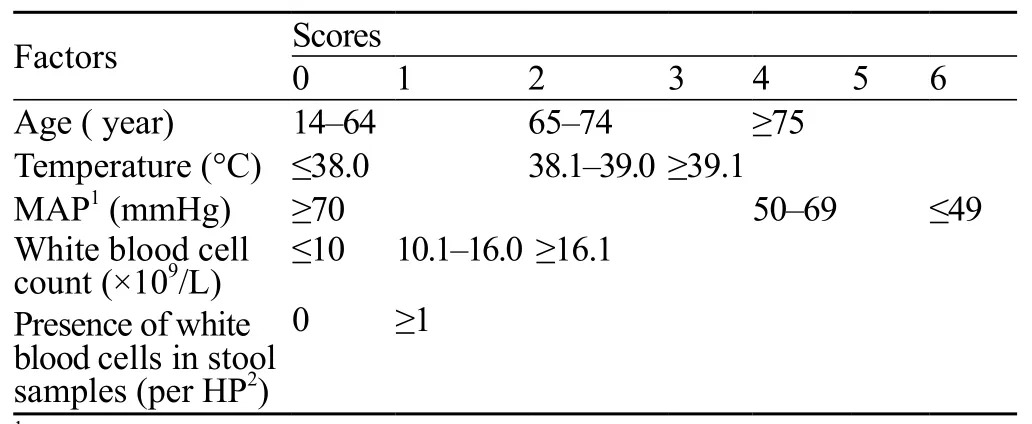
Table 4. The ADSS system
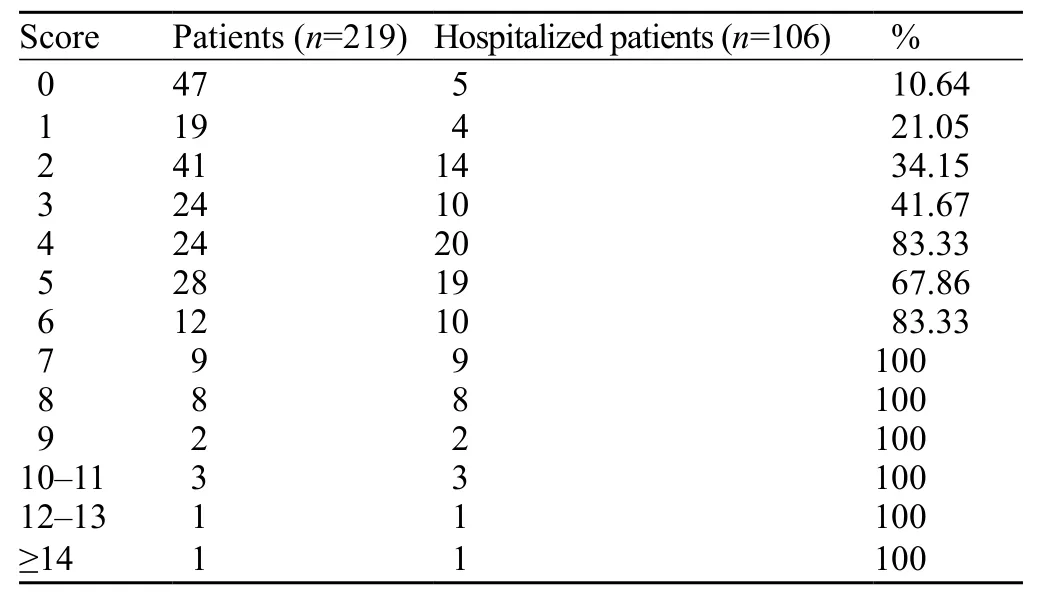
Table 5. ADSS at admission
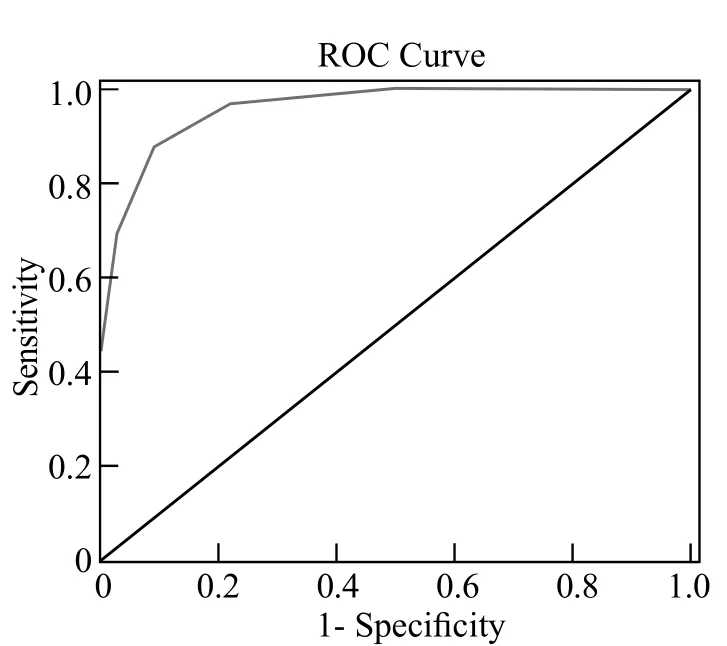
Figure 1. ROC curve for the ADSS system.
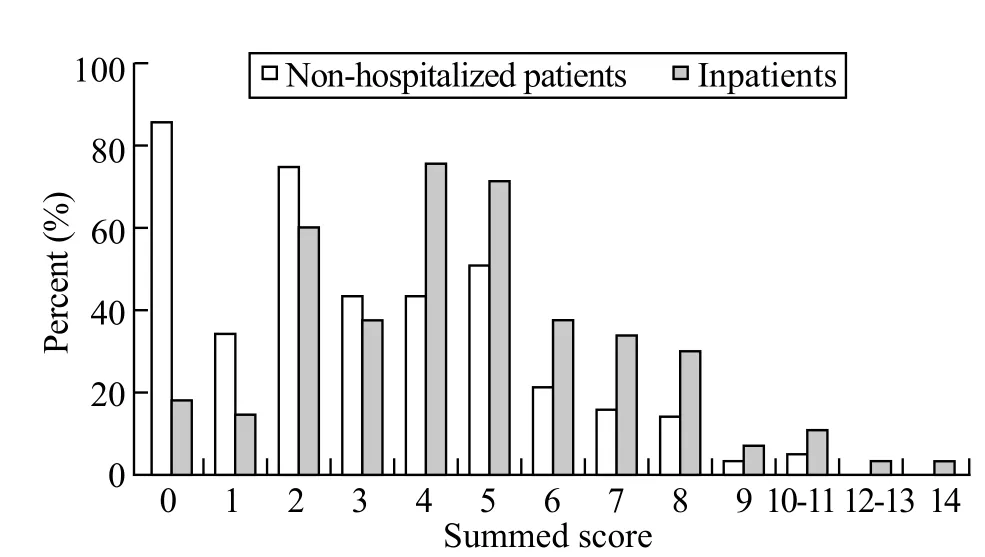
Figure 2. ADSS scores in non-hospitalized patients and inpatients.
DISCUSSION
Diarrhea is one of the most common clinical symptoms. There are 211 to 375 million episodes of acute diarrhea each year, which is associated with 1.8 million hospital admissions annually in the United States.[2]In China, the incidence of diarrhea is about 0.7 times per person and approximately 836 million people suffer from diarrhea annually. However, there are currently no scientific or simple approaches to early and accurately identify the severity of acute diarrhea. Therefore, it is important that screening simple indicators which are associated with disease severity is necessary to determine the severity of diarrhea. ADSS is useful to assess or predict the severity and prognosis of diarrhea and to facilitate timely intervention.
The APACHE system is currently the most commonly used scoring system to assess the severity of illness in adults. It uses age, type of admission, chronic health evaluation, and 12 physiologic variables to forecast hospital mortality, ICU length of stay and the severity of critical illness.[3]Researchers[4]found a simple translational equation to determine the severity of diarrhea: APACHE III=3.08×APACHE II+5.75. In clinical practice, however,the APACHE scoring system has some limitations: it is mainly used to evaluate critical illness in the ICU;determination of some parameters needs about 24 hours;and many primary hospitals, particularly in China, do not collect necessary parameters. Therefore, the APACHE scoring system can not be used in outpatient clinics, in emergency settings or in community hospitals.
The Early Warning Scoring system (EWS) has been widely used in emergency settings and in ICUs in British medical institutions and can identify septic patients in the pre-hospital setting in the case of suspected infection.[5]The most prominent feature of EWS is that the parameters are simple and can be acquired rapidly. EWS is a tool that combines clinical parameters into a single score, and it can be used to identify early signs of deterioration[6]and to assess the condition. Several early warning score tools have been developed and are validated for the recognition of clinical deterioration in adult patients.[7]An increased early warning score has been found to be associated with ICU admission and increased risk for mortality.[8,9]The best model incorporates heart rate, breathing rate, temperature, mean blood pressure, consciousness level and age.
Similar to previous evaluations of early warning systems, the present study supports the use of an objective scoring tool to identify clinical deterioration in patients with acute diarrhea as an emergency manifestation, or as an outpatient or inpatient presentation.
Ideally, prediction rules should be easy, quick and cheap to use, and predict something important and clinically relevant.[10]ADSS satisfies these criteria. Our study represents an evidence-based approach to provide an objective criterion, ADSS, for doctors to assess the clinical condition of outpatients or emergency patients,rather than relying upon extrapolations from experience or "intuition". The parameters of the scoring system include age, mean arterial pressure, body temperature,WBC count and the presence of WBCs in stool samples. All of these parameters are simple to determine and are likely to be instantly available when a patient presents as an emergency or as an outpatient.
AUC is a measure of the diagnostic accuracy of a new diagnostic method. It is believed that an AUC exceeding 0.9 represents high diagnostic accuracy. In this study, the scoring system possesses high accuracy (AUC: 0.958,P<0.01). The cut off value was 4 (a specifi city of 87.4%;a sensitivity of 90.9%), which indicates that a score of 4 should be considered as a "trigger" that should alert doctors of a severe disease and prompt the use of more active prevention and intervention measures. As the score increases, the admission rate also increases. The Kappa statistics is used to evaluate the consistency of ADSS and the actual diagnosis. The higher Kappa value represents greater consistency. In this study, the Kappa value was 0.781 (P<0.01), which represents good consistency and the reliability of ADSS. Therefore, the new scoring system confirms the need for doctors to predict the condition of patients and identify "at risk" patients earlier.
The results show that advanced age is an independent risk factor for the severity of diarrhea. In an analysis[11]of 28 538 deaths from diarrhea among adults aged 55 years and older in the United States, most deaths occurred in persons older than 74 years. Clostridium difficile infection (CDI) is the most common cause of nosocomial infectious diarrhea and may result in severe complications including death, Abou Chakra et al[12]found that age≥80 years was independently associated with complications of CDI. The reasons for this propensity are mainly related to immunosenescence or an overall decrease in immune function as a consequence of advancing age.[13]
Fever and the presence of WBC in stool samples are also factors to consider. Fever, tenesmus, bloody stool and the presence of leukocytes or pus in the stool,erythrocyte sedimentation rate, and fecal lactoferrin are suggestive of inflammatory diarrhea,[14–15]which is one of the leading causes of mortality worldwide.[16]Indeveloped countries, the specificity of fecal lactoferrin is similar to that of microscopy for fecal leukocytes,but has better sensitivity.[17]Fecal examination for leukocytes requires a fresh specimen and examination by a microscopist. However, fecal lactoferrin may be more expensive and is associated with false positives.
Our study, however, also had limitations: First, the sample was relatively small. However, the study represents only a preliminary exploration of an early warning system to assess the severity of diarrhea in adult patients. We are planning further studies with a larger number of patients to retrospectively confi rm and improve the ADSS system developed in this study. Second, acute diarrhea can lead to severe dehydration of patients characterized by thirst,skin mucosal elasticity and urine volume reduction. The degree of dehydration was observed in our study, but due to the subjectivity of this index such as the differences of description for the disease of patients and subjective judgment of doctors, the different accuracy of judgment for the patient's condition leads to the elimination of dehydration indicators. In addition, the present study did not include children. Therefore, it is necessary to introduce an early warning system for doctors to determine the severity of acute diarrhea in children to facilitate timely and appropriate intervention and treatment.
In conclusion, we identifi ed independent risk factors associated with the pathogenic condition of diarrhea in adults, and formulated these factors into an ADSS scoring system. The ADSS system combines indicators into a single score and can be used as a tool for early identification of patients with deteriorating diarrhea to initiate appropriate interventions. A score of 4 has a good discriminatory power to predict severity of diarrhea.
Funding: This work was supported by the National Key Technology R&D Program during the Eleventh Five-year Plan Period [2007BAI24B06].
Ethical approval: Ethical approval was waived for this observational study.
Confl icts of interest: The authors declare that there are no confl icts of interest related to the publication of this paper.
Contributors: Xiao HL and Ma SX contributed equally to this work. Xiao HL and Yin CH designed the study, critically revised the article, and approved the final version. Other authors also contributed to the revision of the article.
REFERENCES
1 Lin M, Dong BQ. Status in epidemiological research of infectious diarrhea. China Tropical Medicine 2008; 8: 675–677.
2 Guerrant RL, Van Gilder T, Steiner TS, Thielman NM, Slutsker L, Tauxe RV, et al. Practice guidelines for the management of infectious diarrhea. Clin Infect Dis 2001; 32: 331–351.
3 Mann SL, Marshall MR, Woodford BJ, Holt A, Williams AB. Predictive performance of Acute Physiological and Chronic Health Evaluation releases II to IV: a single New Zealand centre experience. Anaesth Intensive Care 2012; 40: 479–489.
4 Schneider AG, Lipcsey M, Bailey M, Pilcher DV, Bellomo R. Simple translational equations to compare illness severity scores in intensive care trials. J Crit Care 2013; 28: 885. e1–8.
5 Bayer O, Schwarzkopf D, Stumme C, Stacke A, Hartog CS,Hohenstein C, et al. An Early Warning Scoring System to Identify Septic Patients in the Prehospital Setting: The PRESEP Score. Acad Emerg Med 2015; 22: 868–871.
6 Tucker KM, Brewer TL, Baker RB, Demeritt B, Vossmeyer MT. Prospective evaluation of a pediatric inpatient early warning scoring system. J Spec Pediatr Nurs 2009; 14: 79–85.
7 Cuthbertson BH, Boroujerdi M, McKie L, Aucott L, Prescott G. Can physiological variables and early warning scoring systems allow early recognition of the deteriorating surgical patient? Crit Care Med 2007; 35: 402–409.
8 Goldhill DR, McNarry AF, Mandersloot G, McGinley A. A physiologically-based early warning score for ward patients: The association between score and outcome. Anaesthesia 2005; 60: 547–553.
9 Harrison GA, Jacques T, McLaws ML, Kilborn G. Combinations of early signs of critical illness predict in-hospital death— The SOCCER study (signs of critical conditions and emergency responses). Resuscitation 2006; 71: 327–334.
10 Kellett J, Deane B. The simple clinical score predicts mortality for 30 days after admission to an acute medical unit. QJM 2006;99: 771–781.
11 Lew JF, Glass RI, Gangarosa RE, Cohen IP, Bern C, Moe CL. Diarrheal deaths in the United States, 1979 through 1987: a special problem for the elderly. JAMA 1991; 265: 3280–3284.
12 Abou Chakra CN, McGeer A, Labbé AC, Simor AE, Gold WL, Muller M, et al. Factors associated with Complications of Clostridium difficile Infection in a Multicenter Prospective Cohort. Clin Infect Dis 2015; Sep 3. [Epub ahead of print]
13 Brandt LJ. Bloody diarrhea in an elderly patient. Gastroenterology 2005; 128: 157–163.
14 Pawlowski SW, Warren CA, Guerrant R. Diagnosis and treatment of acute or persistent diarrhea. Gastroenterology 2009;136: 1874–1886.
15 Gonzalez MD, Wilen CB, Burnham CA. Markers of intestinal infl ammation for the diagnosis of infectious gastroenteritis. Clin Lab Med 2015; 35: 333–344
16 Cheng AC, McDonald JR, Thielman NM. Infectious diarrhea in developed and developing countries. J Clin Gastroenterol 2005;39: 757–773.
17 Gill CJ, Lau J, Gorbach SL, Hamer DH. Diagnostic accuracy of stool assays for inflammatory bacterial gastroenteritis in developed and resource-poor countries. Clin Infect Dis 2003; 37: 365–375.
Received November 9, 2015
Accepted after revision April 16, 2016
DOI:10.5847/wjem.j.1920–8642.2016.02.008
杂志排行
World journal of emergency medicine的其它文章
- Evaluation of preventable trauma death in emergency department of Imam Reza hospital
- Application of scoring systems with point-of-care ultrasonography for bedside diagnosis of appendicitis
- Circulating microRNAs as potential biomarkers for diagnosis of congenital heart defects
- Emergency medicine providers' opioid prescribing practices stratifi ed by gender, age, and years in practice
- Instructions for Authors
- An incidental case of Wellens' syndrome in a community emergency department
